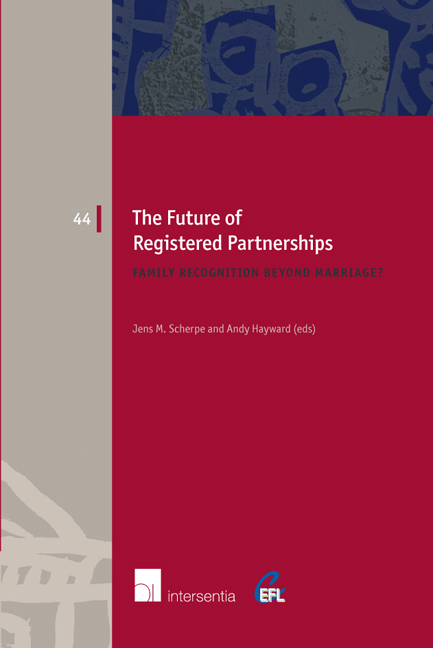Book contents
- Frontmatter
- Foreword
- Preface
- Contents
- List of Contributors
- The Future of Registered Partnerships: An Introduction
- Questionnaire
- Part I Registered Partnerships as a Functional Equivalent to Marriage
- Part II Registered Partnerships as an Alternative to Marriage
- Part III Registered Partnerships in a Time of Transition
- Part IV Alternative Models for Registered Partnerships: Beyond Conjugality, Beyond Formality
- Part V Registered Partnerships, Discrimination and Human Rights
- Part VI Comparative Perspective and Conclusions
- Index
- European Family Law Series
Questionnaire
Published online by Cambridge University Press: 22 September 2018
- Frontmatter
- Foreword
- Preface
- Contents
- List of Contributors
- The Future of Registered Partnerships: An Introduction
- Questionnaire
- Part I Registered Partnerships as a Functional Equivalent to Marriage
- Part II Registered Partnerships as an Alternative to Marriage
- Part III Registered Partnerships in a Time of Transition
- Part IV Alternative Models for Registered Partnerships: Beyond Conjugality, Beyond Formality
- Part V Registered Partnerships, Discrimination and Human Rights
- Part VI Comparative Perspective and Conclusions
- Index
- European Family Law Series
Summary
The aim of this questionnaire is to ensure that the same areas and questions are covered in each National Report for this project. Naturally, there will be instances where some points are not relevant for your jurisdiction – that in itself can be insightful from a comparative law perspective, so please include that information. In other cases, there will be additional relevant information that was not asked for but which of course should also be included.
This questionnaire offers a guideline and should not be viewed as a straitjacket into which the information must fit. However, authors should keep to the Roman and Arabic numerals. Each National Report should be self-contained and readable and, by roughly following the same structure, facilitate comparison. The key driving force behind using the questionnaire is to get a full sense of the legal, social and cultural context underpinning the legal developments in each of these jurisdictions. Therefore, the historical background as well as parliamentary and public debates that led to the introduction, reform or abolition of registered partnership legislation are essential; it is exactly this invaluable context or ‘insider knowledge’ (only really accessible to experts situated within a jurisdiction) that the National Reports should depict. In addition, statistical data on the uptake of registered partnerships would be extremely helpful, particularly data on the uptake in comparison to marriage. Individual comment and critique of the developments and debates, of course, is most welcome.
HISTORY AND BACKGROUND
Basic structures of the law on adult relationships Please describe the basic structures of the law governing (or having governed, where regimes were abolished) adult relationships, i.e. marriage, registered partnership and cohabitation/de facto relationships.
Motives for introduction of registered partnership Where did the initiative to introduce registered partnerships come from? Was it purely a parliamentary one or were specific interest groups involved? Did human rights arguments/international treaty obligations play a significant role?
Proponents and opponents Was the introduction of the registered partnership scheme controversial? If so, who were the main opponents and proponents – and what were their arguments? What was the view of the general public?
- Type
- Chapter
- Information
- The Future of Registered PartnershipsFamily Recognition Beyond Marriage?, pp. 11 - 16Publisher: IntersentiaPrint publication year: 2017

